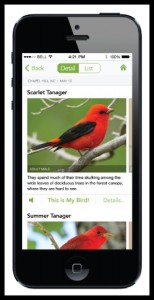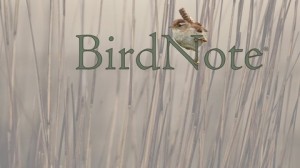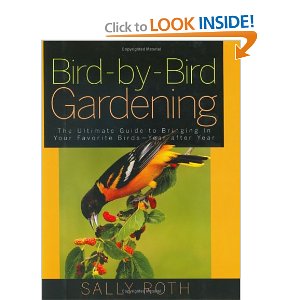Once a few years ago, my husband was talking on the phone near an open window. The person on the other end of the line asked, “Where are you? It sounds like you are in a park.”
The noise the caller was hearing was the early morning chorus of the birds. Serendipity Gardens is home to quite a few avian species. The ones that come readily to mind are red-winged blackbirds, robins, black-capped chickadees, sparrows, house finches, bluejays, cardinals, goldfinches, mourning doves, downy woodpeckers, hummingbirds, wrens, and last year for the first time, two brown thrashers. In addition, cedar waxwings usually visit when the berries on the serviceberry tree are ripe. There are others, I suspect, that I cannot identify.
Learning about Birds
I make no claim to be a bird expert. I do, however, enjoy the birds in the garden, and I have a yen to attract more. I also want to learn to identify the birds I see and hear more easily and accurately. To achieve these goals, I often find myself looking at a bird book, perusing a website about birds, or using a web app to identify who is visiting my bird feeder.
In this blog post, I’ll list some of my favorite resources for people who, like me, are not experts, but want to learn more. Perhaps you will enjoy these resources as much as I do.
Identifying Birds by Sight: Merlin
 I use a bird ID app on my iPhone called Merlin. Also available on Android, it’s published by the Cornell Lab of Ornithology (see below). I have had other, more complicated bird ID apps, but Merlin is my favorite. It’s so simple and easy to use. All you do is answer five questions: where you are, the date on which you saw the bird, the bird’s main colors, its size, and what it is doing. From there, the app supplies you with possible birds that fit the bill (no pun intended). Each bird description includes facts about the bird in addition to one or more photos. You can listen to the songs and calls of the bird as well.
I use a bird ID app on my iPhone called Merlin. Also available on Android, it’s published by the Cornell Lab of Ornithology (see below). I have had other, more complicated bird ID apps, but Merlin is my favorite. It’s so simple and easy to use. All you do is answer five questions: where you are, the date on which you saw the bird, the bird’s main colors, its size, and what it is doing. From there, the app supplies you with possible birds that fit the bill (no pun intended). Each bird description includes facts about the bird in addition to one or more photos. You can listen to the songs and calls of the bird as well.
Using Merlin in the garden, I successfully identified my brown thrashers. Using it at another location, I successfully identified a dark-eyed junco, a titmouse, and a white-breasted nuthatch. It’s quite a lot of fun to do — and the app is simple enough to use with children.
Identifying Birds by Sound: BirdNote
 Merlin works for identifying birds by sound, too, but there’s a great website that I like to visit from time to time as well to learn about the songs and calls of birds — BirdNote. BirdNote provides stories about birds. According to the website, BirdNote is “the product and vision of a passionate group of individuals dedicated to birds and the environment. This collaboration blends art, science, hard work, and dedication to bring each story to life.”
Merlin works for identifying birds by sound, too, but there’s a great website that I like to visit from time to time as well to learn about the songs and calls of birds — BirdNote. BirdNote provides stories about birds. According to the website, BirdNote is “the product and vision of a passionate group of individuals dedicated to birds and the environment. This collaboration blends art, science, hard work, and dedication to bring each story to life.”
Here is the story for November 19.
The Bird Note stories are short, usually about two minutes. You can listen via podcast, the radio, or the website. On the website, you will also find an archive of past stories, lots of great bird photos, and a bird calendar to purchase. You can also sign up for email updates that let you know what’s coming up. If you visit the site now, you can enter a contest to win a trip for two on one of three bird-watching excursions.
Attracting Birds to Your Yard: Bird-By-Bird Gardening
The most important thing to do to attract birds to your yard is, of course, to provide habitat. This means that food and water are available, as well as places to shelter and raise young.
 To learn more about what to do to attract specific species, though, I turned to Bird-by-Bird Gardening, by Sally Roth. More experienced bird enthusiasts might find the book to be too elementary, but for my purposes, it is just right.
To learn more about what to do to attract specific species, though, I turned to Bird-by-Bird Gardening, by Sally Roth. More experienced bird enthusiasts might find the book to be too elementary, but for my purposes, it is just right.
The book divides birds into families, and lists ways to attract members of the family to your yard. For example, this book taught me that orioles are members of the blackbird family and have a sweet tooth. One good way to attract them is to put out citrus fruits or jelly.
An interesting piece of advice in the book is to figure out which weeds you can live with and intentionally leave a few. Their seeds can be the way to a specific seed-eating bird’s heart.
Participating in Citizen Science Projects: Cornell Lab of Ornithology
The Cornell Lab of Ornithology is one of the most comprehensive websites about birds available. It is always my first destination when I need a fact about birds. It has all sorts of information, photos and descriptions of birds, and even courses you can sign up for. The site also has compilations of data about birds. Right now, it has a fabulous set of short videos about birdsong. I hope you’ll take a few minutes to watch the videos.
One of my favorite reasons for liking this site are the Citizen Science projects it supports. You can join in and add your data to:
 Project FeederWatch is going on right now. Visit the site to sign up and join in the fun. Again, this is a great thing to do with kids, who can help you count and learn about birds all at the same time.
Project FeederWatch is going on right now. Visit the site to sign up and join in the fun. Again, this is a great thing to do with kids, who can help you count and learn about birds all at the same time.
Back to the Garden
Each summer, we probably have eight or nine nesting pairs in Serendipity Gardens. A favorite activity of ours is watching all the nest-building activity that occurs in the spring. In deep summer, we often watch the goldfinches drop from a high wire down to the little stream below to bathe and play. Year round, we like to keep a bird feeder and watch the antics of the birds as they compete for food. We often listen to bird song and try to identify who is singing.
How do you enjoy the birds in your garden?
Related Stories
- Blackbirds Arrive March 4 at Serendipity Gardens Five Years in a Row!
- Be a Citizen Scientist: Join the Great Backyard Bird Count
- These Berries Didn’t Last
Like this post? Sign up to receive an email each time a new post is available. We will never loan, sell or rent your email address — that’s a promise! Please use the buttons below to share with others.